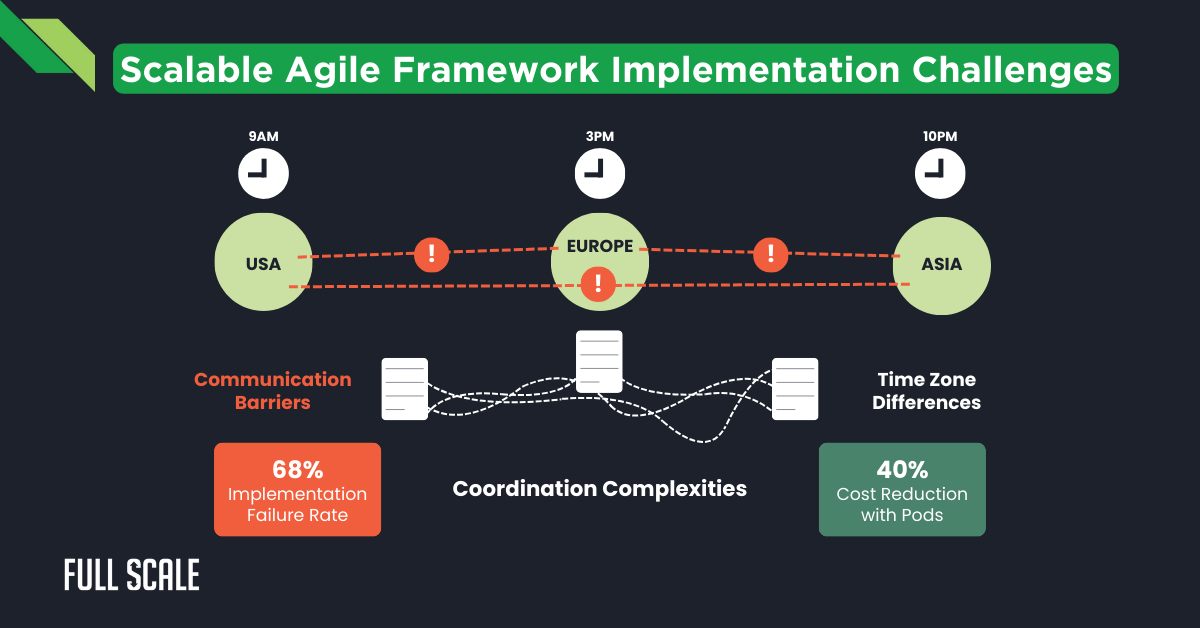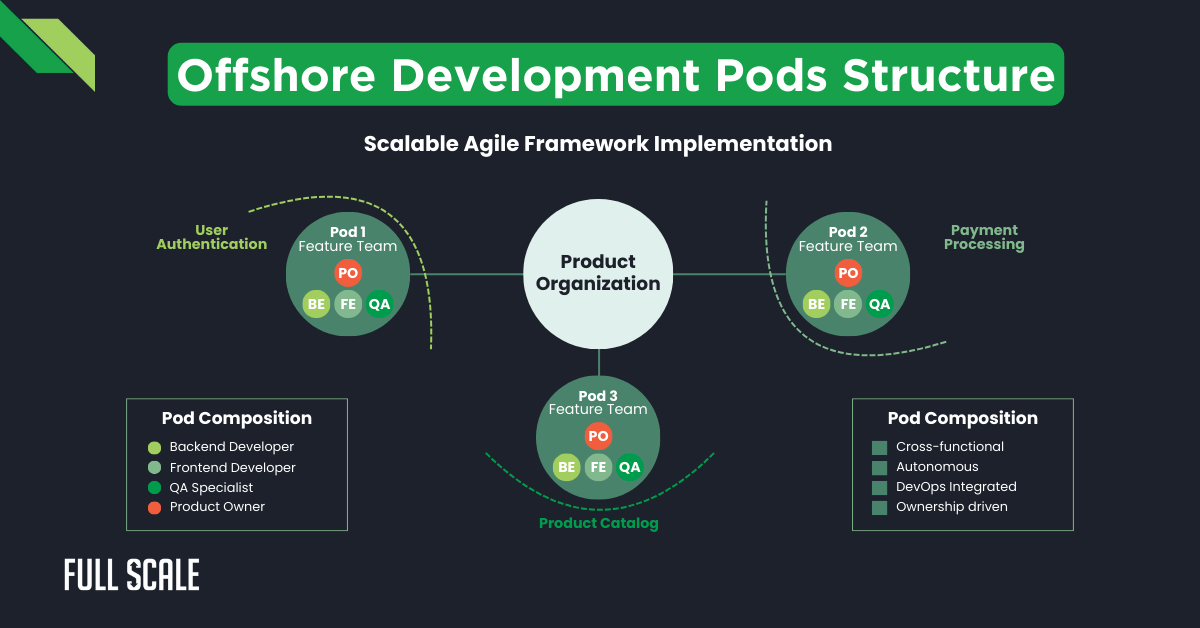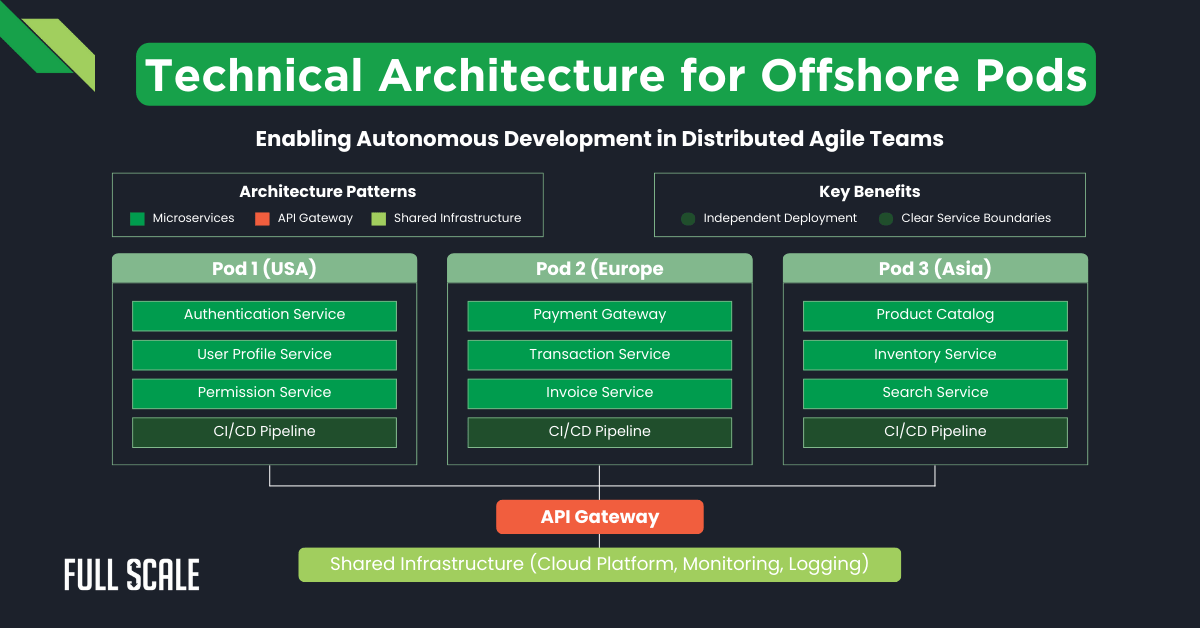According to recent industry research from McKinsey & Company, 68% of distributed Agile implementations fail to deliver expected results.
CTOs and VPs of Engineering face significant challenges when implementing a Scalable Agile Framework with offshore teams. These challenges often manifest as missed deadlines, quality issues, and unexpected budget overruns.
A well-structured offshore development pods model can enhance the Scalable Framework implementation while reducing costs by up to 40%.
Here’s what you need to know about implementing an Agile Framework with offshore teams:
- Failed implementations are common—According to the 2024 State of Agile Report, 7 out of 10 distributed Agile scaling attempts struggle to achieve desired outcomes
- Technical leaders face unique challenges—Communication barriers, time zone differences, and cultural misalignment create additional complexity for offshore Agile implementation
- Structured pod models solve these problems—A well-designed offshore pod approach can enhance your Scalable Agile Framework while reducing development costs
- Proven success record—Our implementation methodology has delivered measurable results for dozens of enterprise clients

This diagram illustrates common challenges when implementing the framework with distributed teams. The visualization shows communication barriers, time zone differences, and coordination complexities.
The Evolution of Agile at Scale
Traditional Agile methodologies were designed for small, co-located teams. This approach creates limitations when applied to enterprise environments with multiple teams. These constraints become evident when organizations need to coordinate numerous interdependent workstreams.
The development community has responded with several scaling frameworks to address these challenges. The table below compares common Agile scaling approaches used with distributed teams.
| Framework | Best For | Key Strengths | Limitations with Offshore Teams |
| SAFe (Scaled Agile Framework) | Large enterprises | Comprehensive structure, Portfolio management | Complex implementation, Requires significant training |
| LeSS (Large-Scale Scrum) | Product-focused companies | Simplicity, Single product backlog | Challenging with timezone differences |
| Nexus | Mid-sized organizations | Focus on dependencies, Practical integration | Limited guidance for distributed teams |
| Spotify Model | Tech companies with strong culture | Team autonomy, Cultural alignment | Difficult to replicate without strong foundations |
These frameworks provide valuable structures but don’t specifically address the unique challenges of offshore development. The emergence of pod-based structures represents an evolution of the Scaling Agile methodology designed to solve this problem.

This diagram shows the optimal structure of offshore development pods within a scalable framework. Each pod contains cross-functional team members with clear ownership boundaries.
Defining the Offshore Pod Model
A true development “pod” differs significantly from traditional distributed Agile teams. Pods represent self-contained, cross-functional units with end-to-end capabilities. These offshore development pods operate with high autonomy while maintaining alignment with business objectives.
Core elements of high-performing offshore pods include:
1. Cross-functional Composition
Each pod contains all the skills needed to deliver complete features. This structure minimizes dependencies and reduces coordination overhead. Effective offshore development pods typically include frontend and backend developers, QA specialists, and a product owner proxy.
2. Autonomous Decision-Making Capabilities
Effective pods have the authority to make technical decisions within their domain. This autonomy accelerates development velocity by removing approval bottlenecks that often plague offshore Agile implementation. Teams maintain responsibility for architecture choices and quality assurance.
3. Integrated DevOps Practices
Successful offshore pods incorporate DevOps capabilities directly into the team. This approach eliminates handoff delays between development and operations in distributed Agile teams. The integration enables continuous delivery pipelines managed by the pod itself.
4. Ownership-driven Culture
High-performing pods take complete ownership of their deliverables within the framework. This ownership mentality drives quality and accountability throughout the development process. Teams maintain responsibility for the full software lifecycle.
Case Study: HealthTech SaaS provider MediTrack restructured its teams into offshore development pods, accelerating delivery by 35%. They shifted from function-based teams to four feature-based pods, with complete ownership of product modules.
Architectural Considerations for Scalable Offshore Pods
The right technical architecture forms the foundation for successful offshore Agile implementation. Several architectural approaches enable pod scalability and autonomy within your framework.
Microservices architecture provides the ideal foundation for offshore development pods. This approach allows each pod to own distinct services with clear boundaries. The table below outlines key benefits for distributed Agile teams.
| Architectural Element | Traditional Approach | Microservices Approach | Impact on Offshore Pods |
| Codebase | Monolithic, shared | Distributed, service-based | Enables parallel work with minimal conflicts |
| Deployment | Coordinated, infrequent | Independent, continuous | Reduces cross-team dependencies |
| Scaling | Whole-application | Service-level | Allows efficient resource allocation |
| Fault Isolation | System-wide impact | Service-level containment | Improves stability and troubleshooting |
API-first design principles enhance distributed team effectiveness. These interfaces serve as contracts between services, enabling autonomous development by offshore development pods.
Technical debt management requires special protocols for distributed Agile teams. Successful implementations include automated code quality gates, technical debt review ceremonies, and dedicated refactoring sprints.
Real-world Example: FinTech payment processor PayStream maintained code quality while scaling from 2 to 8 offshore pods. Their implementation included specialized service boundaries and API versioning protocols.

This diagram illustrates the technical architecture that supports effective offshore development pods. Microservices, API gateways, and continuous integration pipelines enable autonomous work across distributed teams.
Communication and Collaboration Framework
Effective communication represents the most significant challenge in offshore Agile implementation. A structured approach bridges geographic and temporal gaps for distributed Agile teams.
Synchronous and asynchronous communication models must blend effectively for offshore development pods. The table below outlines optimal approaches for different communication needs.
| Communication Type | Best Format | Recommended Tools | Best Practices |
| Daily Coordination | Synchronous, 15-30 min overlap | Video conferences, Daily standup | Record for team members who can’t attend live |
| Technical Discussions | Asynchronous, with optional sync sessions | Documentation, Recorded videos | Use visual aids, diagrams, and code examples |
| Sprint Planning | Semi-synchronous | Collaborative planning tools | Split into preparation (async) and confirmation (sync) |
| Retrospectives | Synchronous | Retrospective platforms | Schedule during overlap hours, capture action items clearly |
Modified Agile ceremonies enhance cross-timezone effectiveness for distributed Agile teams. Successful implementations use asynchronous status updates, recorded stand-ups, and written summaries of decisions.
The CTO of the distributed organization GlobalTech emphasizes: “The key success factor for our offshore pods was creating a ‘follow-the-sun’ workflow with clear handoff protocols.”
Scaling the Offshore Pod Model
Organizations must make strategic choices when expanding their Agile Framework with offshore components.
The approach to scaling affects team dynamics and management overhead for distributed Agile teams. Pod multiplication strategies fall into two main categories:
Vertical Scaling
This approach involves increasing the size of existing offshore development pods. Teams grow from 5–7 members to 10–12 with broader skill sets. This method maintains domain knowledge but introduces internal coordination challenges.
Horizontal Scaling
This strategy creates new offshore development pods with focused domains. Each pod maintains the ideal size of 5–7 members. This approach preserves team dynamics but requires more cross-pod coordination mechanisms.
Inter-pod coordination becomes essential as distributed Agile teams multiply. Successful implementations use cross-pod integration teams, Community of Practice groups, and dependency visualization boards.
Case Study: E-commerce platform ShopDirect scaled from 50 to 300 developers using offshore pods. Their Scaling Agile methodology structured teams around customer journeys rather than technical components.
Common Challenges and Solutions
Despite best practices, implementing an Agile Framework with offshore pods faces several common challenges. Awareness of these pitfalls enables proactive mitigation for distributed Agile teams.
Cultural integration challenges can undermine offshore Agile implementation. Effective strategies include cultural awareness training, virtual team-building, and documentation of implicit cultural norms.
Knowledge silos develop when information doesn’t flow between locations. Prevention techniques for offshore development pods include pair programming, knowledge sharing sessions, and documentation review practices.
Lessons Learned: A healthcare technology company created pods without clear ownership boundaries, leading to duplicate work and accountability problems in their implementation.
Roadmap to Successful Implementation
Organizations should adopt a structured approach when adopting the Agile Framework with offshore pods. This methodical implementation increases the probability of success for distributed Agile teams.
The assessment phase evaluates organizational readiness for offshore Agile implementation. Key readiness factors include technical architecture compatibility, cultural readiness, and product modularity potential.
A pilot program provides the safest entry point for offshore development pods. This program typically includes selecting a suitable product area, forming 1-2 initial pods, and tailoring communication protocols.
The Future of Agile Framework with Offshore Teams
The Agile Framework with offshore pods delivers significant benefits across multiple dimensions. Organizations typically experience 30–40% faster delivery speeds through effective implementation and 25–45% cost reductions.
Future trends in distributed Agile teams point toward increased automation of coordination activities. AI-assisted tools for managing cross-pod dependencies will reduce management overhead for offshore implementations.
For technology leaders evaluating offshore development pods, consider these next steps:
- Assess your organization’s readiness for distributed Agile
- Identify potential pilot areas with appropriate characteristics
- Evaluate the current architecture for compatibility with pod-based development
- Explore potential offshore partners with Agile Framework expertise
Transform Your Development With Full Scale’s Agile Framework
Successful implementation of an Agile Framework requires the right offshore development partner. At Full Scale, we specialize in building high-performing offshore development pods that seamlessly integrate with your existing processes.
Why Choose Full Scale for Your Agile Implementation
- Pre-Built Offshore Development Pods: Our cross-functional teams are pre-trained in Agile methodologies and pod-based delivery models.
- Proven Scaling Methodology: Our approach allows you to scale horizontally or vertically based on your specific needs.
- Architecture Expertise: Our developers implement the technical patterns needed for successful distributed Agile teams.
- Communication Frameworks: We provide established protocols designed specifically for offshore Agile implementation.
Don’t let scaling challenges limit your development capabilities. Schedule a free consultation today to learn how Full Scale’s offshore pods can accelerate your development.
Start With Our Trial Team Today
FAQs: Scalable Agile Framework
What are the key differences between traditional Agile scaling frameworks and offshore pod implementation?
Traditional scaling frameworks like SAFe and LeSS weren’t designed specifically for distributed teams. Offshore development pods within an Agile Framework differ by:
- Built for geographic distribution from the ground up
- Emphasize asynchronous communication patterns
- Include specialized tools for cross-timezone collaboration
- Feature complete ownership boundaries for each pod
- Incorporate DevOps capabilities directly into each team
How does microservices architecture support Agile Framework implementation?
Microservices architecture creates the technical foundation for a successful Agile Framework implementation with offshore pods by:
- Enabling parallel work through clear service boundaries
- Reducing cross-team dependencies with API contracts
- Allowing independent deployment cycles for each pod
- Improving fault isolation to minimize coordination needs
- Supporting autonomous decision-making within each pod’s domain
What communication tools work best for distributed Agile teams using offshore pods?
Effective offshore Agile implementation requires a blend of synchronous and asynchronous communication tools:
- Video conferencing with recording capabilities for standups
- Documentation platforms with version control for asynchronous decisions
- Visual collaboration tools for remote design sessions
- Knowledge bases for cross-team information sharing
- Specialized code review systems are designed for distributed teams
- Chat platforms with threaded discussions and time zone awareness
How long does it typically take to implement an Agile Framework with offshore pods?
Implementing Agile Framework with offshore development pods typically follows this timeline:
- Assessment and planning: 1-2 months
- Pilot implementation with 1-2 pods: 2-3 months
- Evaluation and adjustment: 1 month
- Scaled implementation: 3-4 months
- Optimization: 2-3 months
Most organizations achieve a steady state with distributed Agile teams within 9-12 months.
What metrics should we track to evaluate offshore pod performance?
When implementing Agile Framework with offshore pods, track these key metrics:
- Cycle time by pod and feature type
- Defect escape rate compared to co-located teams
- Team autonomy score (decisions made without escalation)
- Cross-pod dependency count and resolution time
- Deployment frequency per pod
- Mean time to recovery from incidents
- Team satisfaction and retention rates
How can Full Scale help implement an Agile Framework with offshore pods?
Full Scale specializes in building offshore development pods that seamlessly integrate with your Agile Framework:
- Pre-built cross-functional teams trained in pod-based delivery models
- Established communication protocols designed for offshore Agile implementation
- Technical infrastructure supporting distributed Agile teams
- Scaling expertise for horizontal or vertical pod multiplication
- Proven methodologies for successful offshore pod implementation

Matt Watson is a serial tech entrepreneur who has started four companies and had a nine-figure exit. He was the founder and CTO of VinSolutions, the #1 CRM software used in today’s automotive industry. He has over twenty years of experience working as a tech CTO and building cutting-edge SaaS solutions.
As the CEO of Full Scale, he has helped over 100 tech companies build their software services and development teams. Full Scale specializes in helping tech companies grow by augmenting their in-house teams with software development talent from the Philippines.
Matt hosts Startup Hustle, a top podcast about entrepreneurship with over 6 million downloads. He has a wealth of knowledge about startups and business from his personal experience and from interviewing hundreds of other entrepreneurs.




